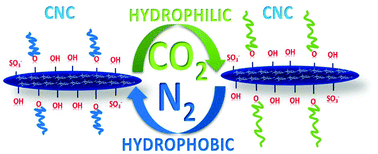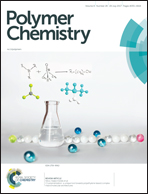Grafting CO2-responsive polymers from cellulose nanocrystals via nitroxide-mediated polymerisation†
Abstract
Cellulose nanocrystals (CNC) are a renewable resource possessing extraordinary physical, mechanical, and optical properties. CNC are readily dispersible only under hydrophilic environments, such as aqueous media and very polar solvents. Different approaches have been attempted to alter the surface properties and thereby improve CNC dispersibility in organic solvents and polymers (hydrophobic media), including functionalisation with small molecules and grafting of polymer chains to the CNC surface. However, when hydrophobic polymer chains are grafted on the CNC surface, the CNC are irreversibly altered toward increased hydrophobicity, which can be undesirable for some applications. Grafting stimuli-responsive polymer chains to the CNC surface offers a solution to this problem. We have synthesized stimuli-responsive CNC whose surface properties can be reversibly switched using only carbon dioxide (CO2) as the trigger to conduct the switching process. The surfaces were modified using surface-initiated nitroxide mediated polymerisation (SI-NMP) with CO2-responsive polymers poly(dimethylaminoethyl methacrylate) (PDMAEMA), poly(diethylaminoethyl methacrylate) (PDEAEMA) and poly(dimethylaminopropyl methacrylamide) (PDMAPMAm).



 Please wait while we load your content...
Please wait while we load your content...